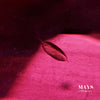Ruby Gemstone Buying Guide
Focusing on the rarest Burmese Rubies
Rubies and Sapphires are the same
Technically speaking, rubies and sapphire are made up of the same mineral, corundum. What separates a ruby from a sapphire is just the colour. Any red variety of the mineral corundum is considered to be ruby and any other colours such as blue, green, yellow or white are considered sapphires.
Why are Rubies cheap?
Don’t be fooled, genuine natural rubies are not cheap. Ruby is one of the most misunderstood gemstones of the past few decades. At least to the majority of the population. Most believe ruby is some cheap red gemstone found in chain jewellery shops of a shopping mall. And it is no fault of theirs. Ruby jewellery available in 'chain jewellery shops’ are generally synthetic (lab-created) or lead glass filled rubies because that's what's commonly available in abundance and at a low cost. Marketed as a cheap and readily available red stone; that's the general misconception of the ruby gemstone. Actual natural gem is so rare that only those who understand its beauty, origin and history can truly appreciate it as a wonder of nature. In fact, natural rubies can be more valuable than diamonds when it comes to pricing per carat. Fine quality rubies never come in enormous sizes and only from specific regions on earth. The finest of rubies originates from Burma (Myanmar). It's the only source in the world for chromium rich rubies. I will explain how chromium is an important factor further on. African rubies are typically iron rich and do not compare in quality.
Natural vs Synthetic Rubies
Believe it or not synthetic or lab created rubies have been around for a century. It was first created by a French chemist named Auguste Verneuil in 1902. Synthetic rubies are created by men in a laboratory and are technically not fakes but certainly don't have the same value as their natural counterparts. Chemically they are identical and so are their physical and optical properties. Natural rubies on the other hand are made in nature through natural geological processes.
Ruby Quality Factors
Just like the 4Cs of a diamond, rubies also have a similar grading system but with more complexity. They have the standard 4Cs: Colour, Clarity, Carat, Cut, plus origin and treatments. The latter two are also relevant with diamonds but not considered as important as in Rubies.

Colour
Colour, in our opinion, is the most important factor when buying a natural ruby. It has a big impact on its pricing. The most popular colour being ‘Pigeon Blood’ which contrary to its literal meaning, is not the colour of the bird’s blood but rather it is the colour of its eye according to Han Htun, a Burmese gemmologist . Needless to say Pigeon’s blood colour of a ruby is like that of blood, a vivid red colour without any brown, purple or orange overtones. That said, rubies have a wide range of hues starting from the pinkish-red to deep garnet like red.
Colour: Saturation and Tone
The difference in saturation and tone can cause a big difference in price. As an example, a ruby that is well saturated in colour but has a very dark tone like that of a garnet has a much lesser value than that of a medium tone. As the colour become less saturated, red becomes pinkish red colour and also has a different value to the more saturated reds. Saturation refers to the amount of colour that’s in a gemstone while the tone indicates the lightness(Light, Medium, Deep) of a stone.
Cause of Colour in Rubies
Ruby in gemmology is classified as an allochromatic gemstone which in laymen terms means that the colour in it is caused by trace impurities. Red is the only colour in the corundum family that has its own variety name of Ruby. All other colours besides red are called sapphires. Ruby or corundum in its pure chemical composition is colourless (aka colourless or white sapphire). The main cause of colour in rubies is the element Chromium. High Chromium content gives the ruby a high intensity vivid red colour.

Clarity
Almost all natural rubies will have some kind of inclusions. It's extremely unlikely that a natural ruby will be internally flawless. So, forget about getting a perfectly clean ruby. Even eye clean rubies are very rare. Most rubies will be included to some extent. One just cannot expect rubies to have the same level of clarity as a diamond, sapphire or spinel. When a natural ruby is available in an exceptional eye clean clarity, be prepared to pay the extra premium especially if it's unheated (not treated).
Carat
Just like carat in diamond, one of the quality factors in assessing a ruby’s quality is its weight (or size) in carats. Natural Burmese Rubies are more valuable than diamonds in pricing per carat in recent auction records. Rubies don't come in large sizes like diamond, at least not in faceted (polished) quality. Sizes above 1.9 carats are starting to become rare. Only specialised high-end gems dealers will carry natural rubies above 2 carats.
Cut
Don’t expect any sorts of fancy cuts in natural rubies like that of some sapphires or other colour gemstones. Typically, lapidarist expect to lose about 70% in weight of the rough gemstone when faceting perfection. Rubies are so rare they are only cut into shapes that the rough material will permit. Anything else would be a waste of rare, expensive material. Almost all rubies that come out of Burma (Myanmar) will be cut to retain maximum weight because they are sold on a price per carat basis.
Origin
Origin refers to the place where a gemstone came from. It could either be natural or synthetic. Synthetic rubies are as you probably have guessed, manufactured by men in a laboratory. Natural rubies are mined from the ground in a few specific locations around the world. Up until the recent decades Burma (Myanmar) supplied most of the world's ruby demand. Now, new natural deposits have been found in countries like Mozambique and Madagascar that supply the majority of the market. Even then, Burmese rubies are still regarded as the finest quality of rubies in the world because of their trace chemical composition. The amount of Chromium contained within a Burmese ruby is unmatched to any other ruby bearing localities in the world.

Record Breaking Mozambican Ruby Sold in 2023
One of the largest natural facet quality rubies ever unearthed dubbed "Estrela de Fura" which translates to "Star of Fura" sold at New York’s Sotheby’s auction house in June 2023. The ruby rough weighs a staggering 101 carats when it was found and was cut into a 55.22 carats sized gem. It was the biggest natural ruby to come on auction and sold for a record breaking price of $34.8 million USD.
Ruby Treatments
Ruby is one of the most commonly treated gemstones because of its high value. To begin to understand treatments, one must understand why it is done in the first place. It all boils down to supply and demand. Natural ruby is considered very rare, being only found in a few localities around the world. With its alluring intense red colours, the demand for them is higher than what the mines can supply. This is where the treatments are used to fill in the supply gap. A treatment will change the appearance of a natural ruby by enhancing the colour or clarity or both. This can turn a lower quality ruby into something of higher quality in appearance. Some treatment methods are acceptable, while some are treated to a point that they are no longer considered rubies. Below is a list of known treatments applied on rubies.

Before and After Heat Treatment
On the left are sapphire roughs before heat treatment. On the right are the same roughs after general heat treatment has been applied. The colour has been enhanced greatly. This is one of the reasons why natural unheated rubies have a higher premium than heated ones. They are already beautiful from nature.
Treated vs Synthetic Rubies
Don’t confuse a treated natural ruby with synthetic rubies. Even though both types are artificially enhanced in appearance, one is unearthed from the ground and the other is manufactured in a laboratory.
Heat Treatment of Rubies (Heat)
Heat treatment of natural rubies is common. Also known as general heat, heat only, or traditional heat in the trade but not to be confused with other types of treatment that also involves the use of heat. When the heating process does not add any foreign substances to the ruby, it’s classified as Natural “Heated” Ruby. This type of treatment is generally acceptable by many as a standard industry practice. The process can improve both the colour and clarity of a ruby. Most of the natural rubies in the market have been treated in this way. The treatment is permanent and stable.
Heated Rubies with Flux (Flux)
This heat treatment is similar to the general heat treatment but the natural rubies are heated together with a type of flux like borax. During the treatment process, the flux enters into the fractures and fissures of ruby. Once cooled (healed), the flux healed fractures are less apparent to the naked eye and thus enhancing the overall clarity.
Beryllium Diffused Rubies (Be)
Sometimes referred to as lattice diffusion, it's different from the traditional surface diffusion on blue sapphires. Beryllium diffusion can penetrate deep into the crystal lattice to form colour zoning within the ruby which will result in an enhancement of colour. The treatment is more common with sapphires but can also be performed on rubies. The treatment is permanent and stable.
Lead Glass Filled Rubies (Pb)
Natural rubies that have been treated in this way are the lowest of all qualities although they have a high quality appearance. Most rubies found at chain jewellery shops at a local mall available at a low price are of this treated type. Very low quality natural rubies of near transparent to opaque clarity are heated together with lead glass. The process allows glass to flow into the fractures and fissures of the low quality ruby, hiding them. The treatment is not permanent and unstable. Lead glass filled rubies are known to have many durability issues.
Surface Filling of Rubies
As the name suggests, this treatment is applied to the surface of a ruby. Natural ruby rough can come with many inclusions including cavities. After the stone is cut, sometimes, these cavities can appear on the surface. Rather than grinding down the ruby to remove the holes (which will result in a smaller gemstone overall), they are filled with glass-like silicon fillers like patching potholes on a road.
Untreated Ruby
This is a term commonly used in the trade that buyers have to be aware of. An Untreated Ruby doesn't necessarily mean the ruby is free from any treatments. It should but the word's definition has been lost in translation through sellers whose main language is not English. Untreated rubies usually just means they are not glass fracture filled but can sometimes still be heat treated.
Ruby Treatment Terms
There are many different terms used to describe the types of treatments applied on rubies. Many sellers will introduce new terms which may confuse an unsuspecting buyer. Below is a list of known commonly used treatment names used in the industry.
| Trade Term | Possible Treatments |
|---|---|
| Unheated Ruby | No Treatments |
| Untreated Ruby | Heat or No Treatments |
| Heated Ruby | Heat, Be, Pb, Flux |
| Heat Only | Heat |
| Traditional Heat | Heat |
| General Heat | Heat |
| Treated Ruby | Pb, Be, Flux, Heat |
| Diffusion Treated Ruby | Treated, Be |
| Fracture Filled Ruby | Treated, Pb |
| Lead Glass Filled Ruby | Treated, Pb |
| Clarity Enhanced Ruby | Treated, Pb |
| Flux Healed Ruby | Heat, Flux |
Natural Ruby Price Guide 2024
The price of a ruby is dependant on all the factors above: Colour, Clarity, Cut, Weight, Treatment and Origin. It’s important to consider all the factor on each stone to determine its price. Note that this is a rough price guide and does not take into account every possible factors that affects the value of rubies. Prices are is based on faceted rubies of top colour, eye clean clarity with average to excellent cut. Current as of 2024.
| Colour/ Origin | Carat | Price Per Carat (USD) |
|---|---|---|
| Pigeon Blood - Burma Unheated | 1.0 - 2.0 | $20,000 - $30,000 |
| - | 2.0 - 3.0 | $30,000 - $60,000 |
| - | 5.0+ | $150,000+ |
| Red - Burma Unheated | 1.0 - 2.0 | $8000 - $10,000 |
| - | 2.0 - 3.0 | $10,000 - $25,000 |
| - | 5.0+ | $80,000+ |
| Vivid Red - Mozambique Unheated | 1.0 - 2.0 | $7000 - $15,000 |
| Pinkish Red - Burma Unheated | 1.0 - 2.0 | $3000 - $12,000 |
Care and Handling
Rubies are 9 on Moh's hardness scale second only to diamonds. They are a very durable gemstone ideal for all types of jewellery including engagement rings and jewellery for everyday wear. The mineral does not show any cleaving properties, although it should still be handled with care to avoid chips through impact just like any other gemstones. Lead glass filled rubies are less durable and need special attention when handling. Below is a list of special handling instructions for jewellers.
Jeweller's Torch
Natural ruby is considered safe around a jeweller's torch. Avoid direct flame onto the gemstone. Higher level of caution needs to be taken when handling included rubies especially the ones with surface reaching fractures. Lead glass filled rubies cannot go anywhere near the jeweller's torch.
Chemical
Rubies are all-round chemically resistant. Safe to be placed in a jeweller's pickle except for lead glass filled rubies and rubies with surface in-fillings.
Ultrasonic
Ultrasonic is generally fine to use on rubies. Care must be taken to not prolong the use of ultrasonic when cleaning included Rubies. Prolonged cleaning in the ultrasonic may cause existing fractures to expand. Extra caution needed for lead glass filled rubies.
Steam
Ruby is safe with a steam cleaner.
Sources of Rough Ruby Gemstone
Burma
500 AD - Current
Burmese Rubies are perhaps the most well known in the world for their colour and quality. There are three different localities where rubies are found in Burma: Mong Hsu, Mogok and Namya. Rubies mined from Burma are known to have the highest Chromium content compared to anywhere else in the world. The resultant ruby is strongly fluorescent under UV rays. Mining operations in Mogok have been recorded in history to date back to the 6th century AD. The area has been under strict control by the different rulers of the land over time up until now. Through 1889-1931, when Burma was under the British colony, mining in Mogok was conducted by a British firm Burma Ruby Mines Ltd. Their studies showed that the highest yielding deposits would be underneath Mogok which lead to the relocation of the entire village. In 1929, prolonged monsoon rain storms flooded the mine which formed the lake in the middle of Mogok as we see it today.
Another important source(but not well known) for Burmese rubies is located in a remote mountainous area called Namya or Nanya (aka Nanyazeik) in Kachin state, upper Burma. Mining activities only began in the late 90s and production is kept at a minimum because of the difficult terrain.
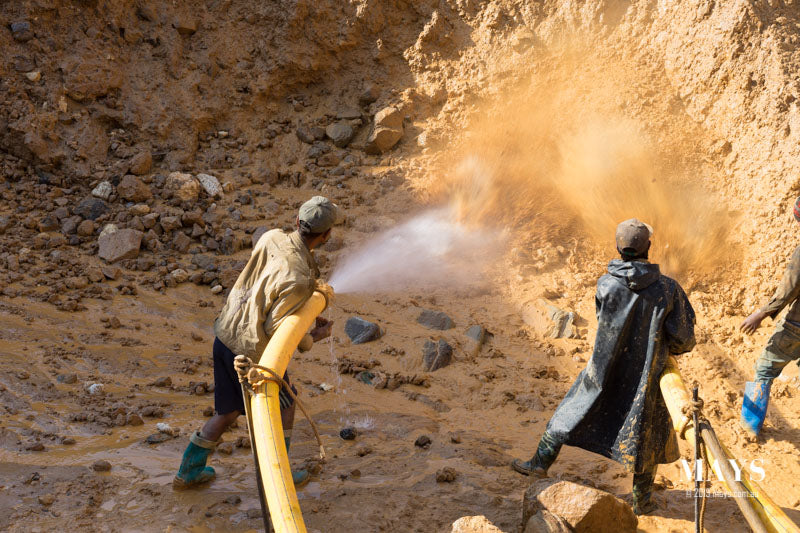 Open pit mine in Mansin, Mogok, Myanmar where miner use high pressure hoses to wash down gem bearing mountain side.
Open pit mine in Mansin, Mogok, Myanmar where miner use high pressure hoses to wash down gem bearing mountain side.
Sri Lanka
334 BC - Current
Sri Lanka gem gravels have produced a very small portion of the ruby supplies in the world. Rubies found here are lightly saturated in colour and tend to be more on the pinkish-red side of the spectrum. Though the source is there, not many rubies have been found but those that have been found are analysed to have near equal levels of Chromium as Burma rubies.
Afghanistan / Tajikistan
2000s - Current
Rubies from this region are also comparable to that from Burma but very little facet quality rubies are found and not enough to warrant as an important source.
Madagascar
2000s - Current
Rubies from Madagascar are a recent discovery, found only in the 2000s. There are two main deposit sites: Vatomandry and Didy.
Vietnam
1980s - Current
Vietnam has produce some rubies that can be matched with the Burmese ruby quality from the Luc Yen region , north of Hanoi. Only very little qualities have been found even for the lower cabochon grades.
Tanzania
1990s - Current
Small quantities of high quality rubies have been found from the Winza deposit. Although most are not facet quality. Low quality rubies found from this region are usually heat treated with lead glass.
Mozambique
1980s - Current
Mozambique is currently the largest supplier of Rubies to the world market. Some of the largest rubies were found here. Rubies from this locality tend to be richer in iron than Chromium. Although fine stones have been mined out of this region.
Synthetics
1902 - Current
Synthetic rubies have been in production since the early 1900s. The method was created by Verneuil and it's called the Verneuil flame-fusion method. Synthetic rubies made this way are widely available in abundance at a low cost. Today, there are advanced methods in creating synthetic rubies such as Hydrothermal and Flux. Synthetic rubies are mainly used to imitate their natural counterpart. Identifying a synthetic ruby can be performed by a trained gemologist through the use of standard gemological instruments.
Ruby Inclusions
The study of inclusions inside of a ruby is important for gemmologists because these minute clues can shine light on the identity of a ruby, where it came from and if it has been treated. Certain inclusions are only found from a specific source or mine site. Experts find these inclusions to pinpoint the origin of the gemstone be it natural or synthetic. There are the inclusions that are only found in rubies and never in any other gemstones. Such inclusions can be used to separate rubies from others. Finally, if the ruby has been heat treated, there are clues left behind from the heating process that can be revealed under a microscope. Visit our inclusions gallery here: Natural Ruby Inclusions.
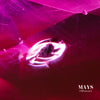
A discoid fracture around a dark coloured crystal, possibly zircon seen inside of an Unheated Burmese Ruby from Mogok.
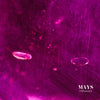
An elongated crystal, likely to be an apatite inclusion among multi-directional fine rutile needles. These are clear indicators that this Burmese ruby is unheated.
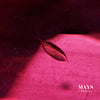
An oval shaped crystal inclusion. possibly apatite, inside an unheated Burmese ruby.
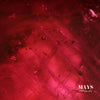
Twinning planes and a gas bubble can be seen inside this African glass filled ruby.
Historically Significant Rubies

Timur Ruby
The Timur Ruby which weighs in at 352.5ct and was believed to be the largest ruby in the world until 1851. The blood red coloured polished rough was found to be a red spinel. It’s named after the Persian king, Timur, who first ruled the Timurid empire across Central Asia and Persia. Inscriptions of names and dates can be found on the stone as it was passed down from each successor of the throne. In 1849 when the British colonised Punjab in India, the Timur Ruby along with the famous Koh-i-noor diamond was found together and was taken from the Lahore Treasury. The East India Company later gifted the stone to Queen Victoria in 1851. It was set into a necklace in 1853. It now remains in the private collection of Queen Elizabeth II.

The Black Prince's Ruby
The Black Prince’s Ruby which currently is mounted on the Imperial State Crown of England is a red spinel despite the name ruby. It was thought to be a ruby until the discovery of a separate mineral called spinel in the late 1700s. The stone weighs approximately 170 carats and is in the shape of a polished rough. The English monarchy acquired the gem as payment of war in 1367 through Edward of Woodstock (The Black Prince), when he helped defeat a rebellion against a petty king of Spain, Don Pedro. Since then, this spinel has survived through many battles being mounted on the helmets of English kings and now sits peacefully on the Queen’s crown. The spinel was probably mined from the famed Balas rubies mines of Tajikistan/Afghanistan formerly known as Badakhshan.
Ruby Mineral Properties
| Chemical Composition | Al2O3 Aluminum Oxide |
|---|---|
| Hardness | 9 |
| Crystal System | Trigonal |
| Transparency | Transparent – Opaque |
| Specific Gravity | 3.97 - 4.08 |
| Reflective Index | 1.762 - 1.770 |
| Birefringence | 0.008 - 0.010 |
| Lustre | Vitreous |
Ruby Misnomers
| Trade Name | Mineral |
|---|---|
| Balas Ruby, Spinel Ruby, Rubicelle | Red Spinel |
| American, Colorado, Arizona, Adelaide Ruby | Red Garnet |
| Brazilian Ruby, Rubellite | Red Tourmaline |
| Ramaura, Chatham, Verneuil, Gilson Ruby | Synthetic Ruby |
| Inamori, Kashan, Zerfass, Kyocera Ruby | Synthetic Ruby |

Wai Yan






